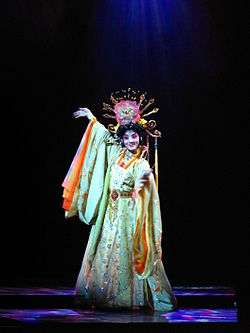Qinqiang
Qinqiang (秦腔, pinyin: Qínqiāng) or Luantan (亂彈, pinyin: Luàntán) is the representative folk Chinese opera of the northwest Province of Shaanxi, China,[1] where it was called Qin thousands of years ago. Its melodies originated from rural areas of ancient Shaanxi and Gansu.[2] The word itself means "the tune or sound of Qin."[3]


The genre uses the bangzi (woodblock) as one of the accompanying instruments, from which it derives its other name, Bangzi opera. Bangzi tune is the oldest, most affluent opera tune in China's Four Great Characteristic Melodies. Qinqiang is the representative of the Bangzi opera and the most important origin of other Bangzi operas.[4] It plays a key role in Chinese traditional culture as its birth and development process is the result of the development of Chinese local opera since ancient times.[5]
It has been researched by people looking to study the historical and cultural connotations of the Qin dynasty and Tan Dun, the composer for the opera The First Emperor, researched Qinqiang for the opera, in order to learn more about "ancient Chinese vocal styles".[6]
History
As the study of Qinqiang was mostly conducted via oral instruction and demonstration, early research on Qinqiang is scant. Qinqiang is believed by scholars to have originated during the Qin dynasty and that it is the originator of Chinese opera. It developed from its prototype Xi Diao, a type of folk opera, and spread throughout China to the provinces of Shaanxi and Gansu.[5][7] There Qinqiang changed over time and gradually formed the basic style of the Qinqiang opera, which continued to be performed throughout 1644 in China. Scholars state that Qinqiang reflects on the personalities and experiences of the working people, as it was impacted by the war and the influence of Western culture and art.[5][5]
The fourteenth version of the play Bozhong Lotus in the Ming Dynasty (1573-1620 A.D.) has been frequently cited as one of the most important and authoritative. The play tells the tale of Gu Lao-er, a cylinder mender. Scholar Qin Bao has stated that the play's seven-character sentence pattern is direct evidence of the formation of the Qinqiang opera plate cavity and that its plot and folk expression is evidence of Qingiang's folk production.[8]
Qinqiang was banned from "being performed in Beijing" in 1785 by the emperor at the time, Qianlong. It was stated that "the sexual suggestiveness of the genre" was the reason for it being banned, but it is believed that the real reason was because the difference in style from prior Chinese folk opera styles allowed social critique of China to be written into them. The ban, however, only ended up expanding the style into more areas outside of Beijing, primarily to theatres in the southeast.[9]
Music style
Qinqiang has four forms of performance: singing, narration, dance, and martial arts. During performances the combination of singing and narrative is used to express other scenes and characters, such as general combat or soldiers attacking enemies on the stage. Supporters of Qiniang state that this creates a unique charm and atmosphere.[5] Actors require a foundation of vocal music, as this is how the character of different humanities is expressed.[5][5]
Characters
There are 13 kinds of characters in Qinqiang including four kinds of "Sheng" (生, male)(老生、須生、小生、幼生), six kinds of "Dan" (旦, female)(老旦、正旦、小旦、花旦、武旦、媒旦), two kinds of "Jing" (淨, painted face male)(大淨、毛淨) and one kind of "Chou" (丑, Clown), also knowns as " 13 Tou Wangzi" (十三頭網子).
Actors
Artist
Yang Wenying, a famous artist after the founding of the People's Republic of China, and his achievements in the study of Qinqiang Opera art. Yang Wenying is a famous director and actor. He adapted many music works of Qinqiang art to promote the development of modern Qinqiang art in China, such as the modern Qinqiang opera “Red coral”, “Red Lantern”, “Ports” and so on.[10]
Musial work
In 1958, Zhao, Zhenxiao and Lu Rilong, professors of Xi'an Conservatory of Music, created the “Capriccio on a Qinqiang Theme”, which is inspired by Shaanxi Opera, in order to promote the development of national music. The “Capriccio on Qinqiang Theme” is a representative work of the Qingqiang style. This music work is written for Erhu, which is called Chinese violin.[11]
References
- "China promove programas diversificados durante o Festival da Primavera". China Radio International. February 8, 2008. Retrieved November 17, 2010. (English)
- "Chinese opera The First Emperor transmitted live into theaters worldwide". People's Daily. January 14, 2007. Retrieved November 17, 2010.
- Yuet Chau, Adam (2006). Miraculous response: doing popular religion in contemporary China. Stanford University Press. p. 53. Retrieved November 17, 2010.
- Women of China. 2001. Retrieved November 17, 2010.
- "国家哲学社会科学文献中心". www.ncpssd.org. Retrieved 2019-07-16.
- Matt Dobkin and Ken Smith (December 6, 2006). "Tan Dun's Operatic Odyssey". Playbill. Retrieved November 17, 2010.
- "The origin and development of Qinqiang". Chinese Opera. 15 Oct 2014.
- Cao, Bin (Dec 2013). "Reflection on Qinqiang historical issues through researching Bozhong Lotus". Boji University of Arts and Sciences.
- Ruru, Li (2010). Soul of Beijing Opera: Creativity and Continuity in Modern Performance. Hong Kong University Press. p. 36. Retrieved November 17, 2010.
- Fu, Zengzhi (1 April 2013). "A Study of Qinqiang Opera Artist Yang Wenying". Shanxi Normal University.
- Zhu, Qiao (2017). "An Analysis of the Artistic Characteristics of Capriccio on Qinqiang Theme". The Home of Opera.
External links
- China Qinqiang Website (Chinese)